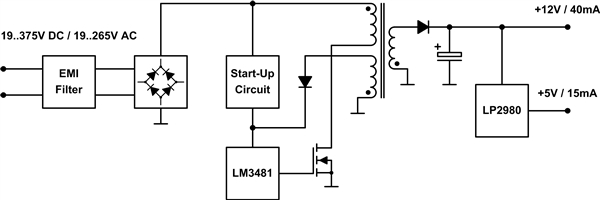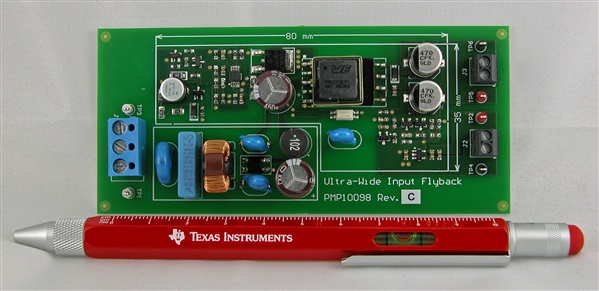SSZTC60 september 2015
A wide variety of supply voltages exist in industrial applications and factory automation. Typically, you’ll find 24VAC, 24VDC, 110VAC, 230VAC and sometimes voltages in-between. Electronic device manufacturers usually don’t like to develop different power supplies for each input voltage because of cost. So let’s look at how to design a low-power flyback converter in the 500mW range with an ultrawide input-voltage range of 19 to 265VAC and 19 to375VDC.
The low power flyback reference design, which I will use as an example in this blog, needs to provide two outputs. One output rail supplies a microcontroller and analog circuitry (5.0V at 15mA); the second rail provides 12.0V at 40mA to control a relay. Because the input and two outputs require an isolation of 2.5kV, the simple and well-known flyback converter comes to mind first.
Figure 1 shows the converter including input filter, rectifier, startup circuit and controller linear regulator on the secondary side.
 Figure 1 Flyback converter block
diagram
Figure 1 Flyback converter block
diagramThe wide-input voltage range is not only a challenge for the controller, but also for the design of the transformer. A flyback converter is designed to work in discontinuous conduction mode (DCCM) for low-power applications in order to achieve a small solution size because of the lower inductance of the coupled inductor. The peak currents in this operation mode are higher compared to continuous conduction mode (CCM) – but because the power is low, they are still relatively small. For higher power, the flyback converter is typically working in CCM. At first glance DCCM seems to be the right mode for this flyback design, with an output power of roughly 500mW.
The switching frequency should be relatively low to avoid high switching losses at the upper range of the input voltage. In this design, it is set to 130kHz so that the fundamental wave is below the lower limit of 150kHz for electromagnetic interference (EMI) measurements. If the converter is supposed to work only in DCCM, the duty cycle is in a range from 70% down to 4% (turns ratio 3.58: 1,750µH primary inductance). To reduce component stress, you should increase the minimum duty cycle by keeping the turns ratio constant and changing the primary inductance to 4mH. The converter is now running in CCM for low-input voltages and in DCCM for high-input voltages.
 Figure 2 Low Power Flyback with Ultra
Wide Input Voltage Range TI Designs reference design
Figure 2 Low Power Flyback with Ultra
Wide Input Voltage Range TI Designs reference design